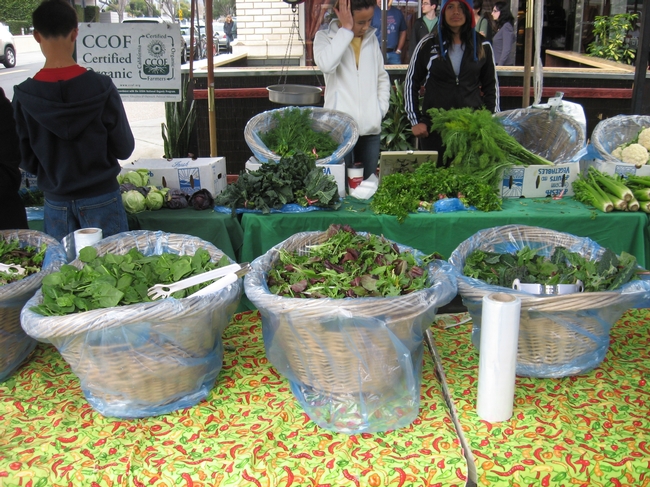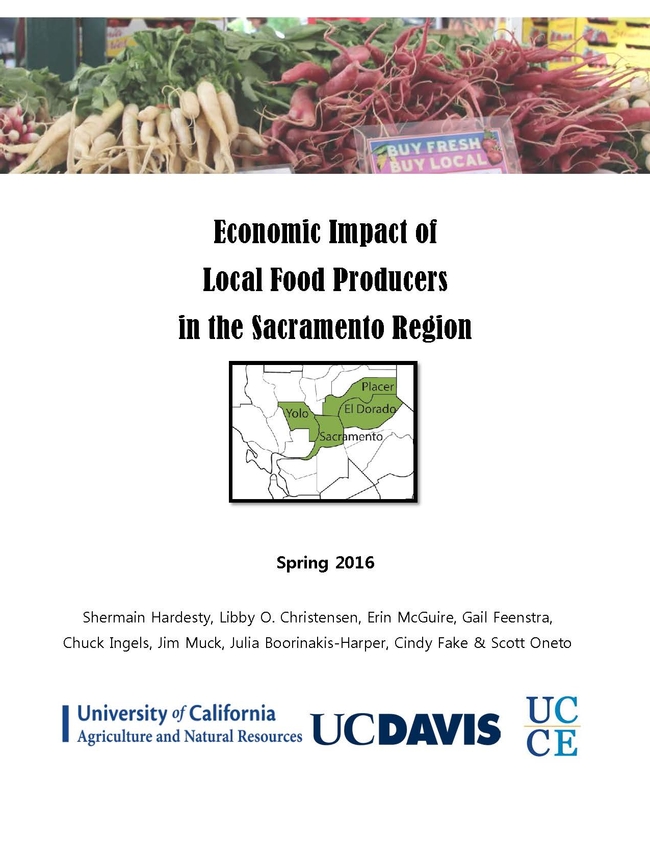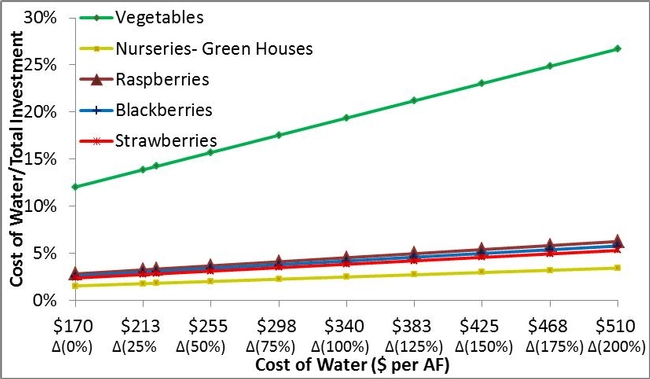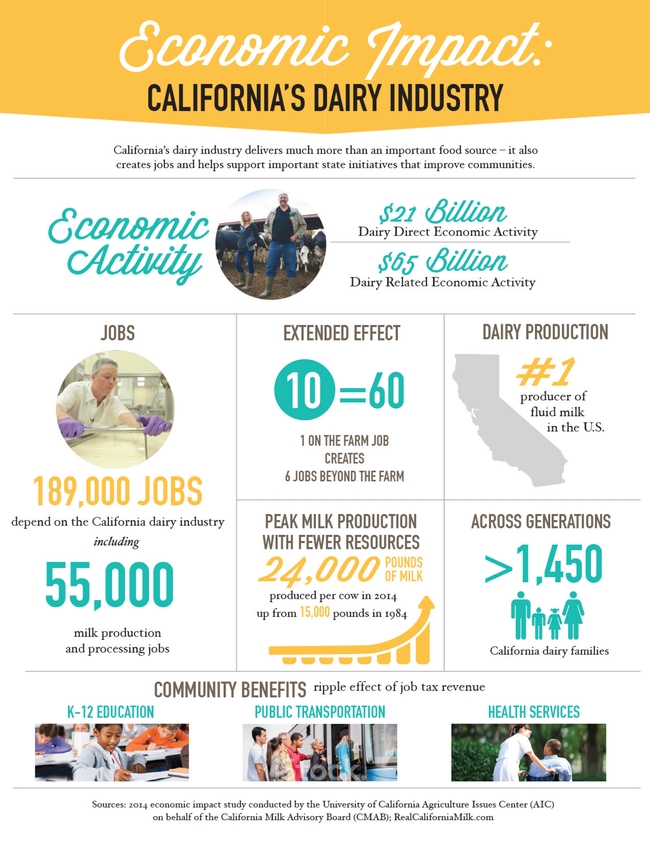
Posts Tagged: economic impact
Economic Impact of Local Food Marketing in the Sacramento Region

Our University of California Cooperative Extension team measured the economic impact of local food marketing in the Sacramento Region (El Dorado, Placer, Sacramento and Yolo counties). Our key finding was that, for every dollar of sales, Sacramento Region producers engaged in direct marketing (direct marketers) are generating twice as much economic activity within the region as producers who are not involved in direct marketing (non-direct marketers). This strong economic development impact is due primarily to the fact that direct marketers source a much larger percentage of their inputs within the region (89 percent) than do non-direct marketers (45 percent).
We used an input-output modeling program, IMPLAN, to measure the direct marketers' economic impacts. Our project team interviewed over 100 direct marketers in the Sacramento Region to develop a customized IMPLAN database. We asked producers what, where, and how much they spent for inputs in various categories, as well as what, where and how much product they sold. The direct marketers were much more labor intensive; hired labor comprised 45 percent of their total expenses, compared to 25 percent of total expenses for the non-direct marketers. Additionally, most direct marketers also sold through other channels; on average, 44 percent of their revenues were generated through direct marketing, 55 percent through wholesale channels, and one percent in commodity markets.
Three levels of economic impact related to local food marketing can be measured: direct, indirect and induced. Imagine a customer goes to a farmers market in the Sacramento region and buys $10 of vegetables from Farmer Brown. There is a direct effect of 1, which generates $10 in revenue for Farmer Brown. There are also ripple effects 
The second ripple effect is called the induced effect. In this example, Farmer Brown spent money to hire labor and purchase inputs. Her spending generates income for her farm, her employees, her suppliers, and the employees of her suppliers—including the sales person at the hardware store. The induced effect occurs when these households spend some of their income on products and services within the region, such as food, clothing, health care, eating out, and recreational activities. The induced effect was .45 for the direct marketers and .33 for the indirect marketers. The induced effect from Farmer Brown's production of $10 of vegetables generated $4.50 of household spending in the Sacramento Region. The direct, indirect and induced effects are added together to calculate the total output multiplier—measuring the total economic impact of one dollar of output. The total output multiplier is 1.86 for the direct marketers, and 1.42 for the non-direct marketers.
There are also large differences in the job effect of the two producer groups. The direct marketers generate 31.8 jobs in the Sacramento Region for every $1 million of output they produce. These jobs include on-farm labor, as well as jobs related to the farms' indirect effects, which involve the farms' suppliers, and jobs created by the direct marketers' induced effects involving household spending. In comparison, the Sacramento Region non-direct marketers generate 10.5 jobs for every $1 million of output. The difference is attributable mainly to two factors: (1) the direct marketers' high rate of local input sourcing; and (2) the direct marketers' labor intensiveness--hired labor expenses comprised 45 percent of their operating expenses, compared to only 25 percent for the other producers.

Readers need to be aware that these results apply only to the Sacramento Region. Gathering the data to develop a custom IMPLAN database for direct marketers is very time-consuming.
Report authors are the following current (and former) UC Cooperative Extension academics and staff: Shermain Hardesty, Libby O. Christensen, Erin McGuire, Gail Feenstra, Chuck Ingels, Jim Muck, Julia Boorinakis-Harper, Cindy Fake and Scott Oneto. The full regional report, as well as similar reports for El Dorado, Placer and Yolo counties, may be downloaded at: http://ucanr.edu/econ_impact. Inquiries may be sent to the project leader, Shermain Hardesty, shermain@primal.ucdavis.edu.
California dairy industry contributes $21 billion to state’s economy

Cementing its place as California's most important agricultural commodity by farm revenue, California farms sold about $9.4 billion worth of milk while the dairy industry contributed approximately $21 billion in value added to the gross state product in 2014, according to a California Milk Advisory Board (CMAB) study conducted by the Agricultural Issues Center, a statewide program of UC Agriculture and Natural Resources. Including sales of inputs to dairy farms and milk processors along with raw milk and wholesale milk product sales, the dairy industry contributed $65 billion in total sales to the California economy in 2014. The growing demand for dairy products like cheese and yogurt as well as strong dairy exports accounted for 189,000 jobs that are dependent on the state's milk production and processing.
“The dairy industry's contributions are vital to California's economy, from creating jobs to stimulating local and regional economies to providing nutritious and enjoyable products to consumers everywhere,” said John Talbot, CEO of the California Milk Advisory Board. “A large number of California residents depend on the dairy industry for employment and these jobs would not exist without it.”
The $21 billion to California's gross state product included $7.4 billion as income to industry workers and owners and $13.4 billion through related, outside industries such as feed, veterinary and accounting services used for dairy production and electricity, packaging, equipment and trucking services used by processors. The tax revenue generated from these jobs supported important statewide initiatives to improve education, healthcare, roads, community services and the environment.
Overall, 189,000 jobs in California are associated with the dairy industry. Of this amount, approximately 30,000 jobs are on the farm and 20,000 jobs represent dairy processing. For every dairy farm job, there are several more jobs that are tied to the business and create a linked chain of economic impacts.
Additionally, the induced effect of the dairy industry also creates jobs in the community to support the area's dairy workers and their families, such as school teachers and local bus drivers.
California Holds Rank as Nation's Dairy Leader
California leads the nation in dairy production and dairy continues as the top commodity in the country's top agricultural state. It has been the nation's largest milk producer since 1993 and is also the country's leading producer of butter, ice cream, nonfat dry milk and whey protein concentrate. California is also the second largest producer of cheese and yogurt.
Farm milk sales generated $9.4 billion gross revenue in 2014. Wholesale dairy product (cheese, fluid milk, ice cream, butter and other dairy) sales hit $25 billion in 2014.
Dairy Farmers Improve Business Performance
As an essential part of California's farming heritage, dairy farmers understand the importance of protecting the land, water and air for their families, their communities and future generations. In 2014, California dairy farmers produced more milk with fewer resources. Talbot credits “improved dairy practices and management adopted by farmers” for the increased business efficiencies. The pounds of milk produced per cow increased to 24,000 pounds in 2014 from 15,000 in 1984. Farmers are applying 23 percent less water to their fields than they did in the early 1980s and have seen their average crop yields increase by more than 40 percent despite using less water.
Beyond the economic impacts calculated in the report, California dairy farmers and employees are active participants in their communities and contribute to social, environmental and other broad public goals.
Study Leaders and Methodology
The study was conducted by a team of researchers at the UC ANR Agricultural Issues Center (AIC). Daniel A. Sumner, the director of AIC who holds the Frank H. Buck, Jr. Chair Professorship in the Department of Agricultural and Resource Economics at UC Davis, led the study. Josué Medellín-Azuara, a project scientist at the UC Davis Center for Watershed Sciences, and Eric Coughlin, a junior research specialist at AIC, were part of the research team. They measured myriad impacts using dairy-specific data for 2012 and projections for 2014 and a database and model of economic linkages (IMPLAN).
About the California Milk Advisory Board
The California Milk Advisory Board (CMAB), an instrumentality of the California Department of Food and Agriculture, is funded by the state's more than 1,450 dairy families. With headquarters in South San Francisco and Modesto, the CMAB is one of the largest U.S. commodity boards. It executes advertising, public relations, research and promotions on behalf of California dairy products, including Real California Milk and Real California Cheese. For more, visit RealCaliforniaMilk.com.
California agriculture to suffer $1 billion in drought losses

The story was based on a report released Tuesday by the UC Davis Center for Watershed Sciences. The 2014 drought, the report says, is responsible for the greatest water loss ever seen in California agriculture - about one third less than normal.
A key concern is the loss of agricultural jobs, said lead author Richard Howitt at a press conference about the report. "What really hurts is you are also losing 17,000 jobs," Howitt said. "(These jobs) are from a sector that has the least ability to roll with the punches."
Consumer food prices will be largely unaffected. Higher prices at the grocery store of high-value California crops like nuts, wine grapes and dairy foods are driven more by market demand than by the drought.
The report calls the groundwater situation in California "a slow-moving train wreck."
“California's agricultural economy overall is doing remarkably well, thanks mostly to groundwater reserves,” said Jay Lund, a co-author of the study and director of the Center for Watershed Sciences. “But we expect substantial local and regional economic and employment impacts. We need to treat that groundwater well so it will be there for future droughts.”
California is currently the only Western state without a framework for groundwater management.
The UC Davis news team has provided these resources about the new drought report:
- Read the full report.
- Watch the recorded webcast of report press briefing.
- Download photos
- Download audio sound bites from lead author.
The report says the Central Valley is hardest hit, particularly the Tulare Basin, with projected losses of $810 million, or 2.3 percent, in crop revenue; $203 million in dairy and livestock value; and $453 million in additional well-pumping costs.
Drought impacts being felt
The ongoing drought has contributed to declines in Fresno County crop values, reported Bob Rodriguez in the Fresno Bee. Fresno County's overall gross value fell 2.2 percent to $6.4 billion in 2013, and with the reduction lost its bragging rights as the No. 1 ag county in California. Tulare County took the No. 1 spot with a record $7.8 billion in ag value, riding on robust dairy prices.
Fresno County Agricultural Commissioner Les Wright said the drought -- one of the worst in state history -- has pinched the production of several west side field crops including cotton, corn silage and barley. The field crop category fell by 42 percent.
Optimizing irrigation may ease groundwater overdraft in Pajaro Valley

Groundwater makes up roughly 90 percent of the water delivered by Pajaro Valley’s Water Management Agency (PVWMA). There is a current overdraft of groundwater in the aquifers of this region, which calls for immediate action to protect their water source. Historically, the amount of groundwater in the aquifer was above sea level so the amount of salt water in the freshwater aquifer was kept at bay. Removing too much water from the ground at a faster rate than it is being replenished has caused seawater from the Pacific Ocean to enter the aquifer as the water level tries to even out. This seawater intrusion impairs water quality because saltwater is too saline for both agriculture and human consumption.


Agricultural conservation program
PVWMA asked Samuel Sandoval Solis, Ph.D., UC Cooperative Extension specialist in the Department of Land, Air and Water Resources at UC Davis, to help them with their agricultural conservation program. PVWMA wanted to know the volume water that could be potentially saved and the resulting economic impact of water savings on the valley.
The key to agricultural water savings is to water a crop to its evapotranspiration (ET) value. The ET value indicates optimum water amounts that should be applied in order for the water to be completely beneficial to the plants. To estimate the potential water savings, Sandoval and his UC Davis team – undergraduate student Vicki Lin and Ph.D. students Jenna Rodriguez and Belize Lane – had to determine how many growers were surpassing a crop’s ET value. The scientists interviewed growers to find out the volume of water each grower applied to the crops and the amount of money they invested in crop production. A statistical analysis was completed with applied water data of growers from PVWMA, information from the growers’ interviews, and expert-provided ET values to check for accuracy.
The scientists also analyzed land-use data sets from 2009 and 2011 for this project. The analysis focused on 2009 because it was a normal year in terms of groundwater extraction. They determined that Pajaro Valley can save between 4,600 and 5,100 acre feet per year through conservation. This agricultural water savings program is anticipated to contribute to 41 percent of the region’s total water savings just by using water more efficiently.
Vegetable growers would take hard hit

The full 37-page report on this project can be downloaded from a link at the top of http://watermanagement.ucdavis.edu/cooperative-extension/water-savings-agriculture.
Feeling the economic pain of drought
Reduced water allowances for farmers could mean layoffs and other economic impacts, says an article in the Wall Street Journal by Jim Carlton.
The article reported that some farmers have been told to expect just 30 percent of their allotments. In response to water cutbacks, many farmers must reduce planting and leave some fields fallow.
The article referenced a UC Davis study, co-authored by Richard Howitt, of 2009 water cutbacks that resulted in "285,000 acres going fallow and the loss of 9,800 agricultural jobs, for a $340 million loss in farm-related revenues."


